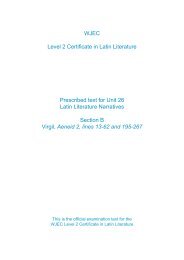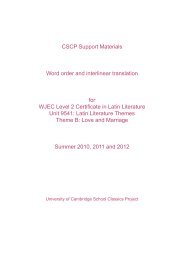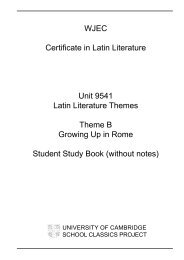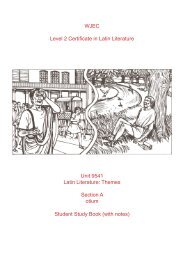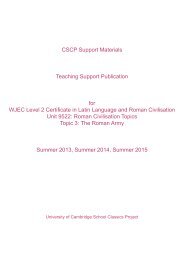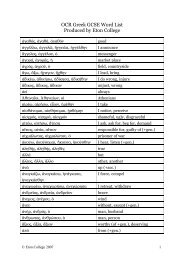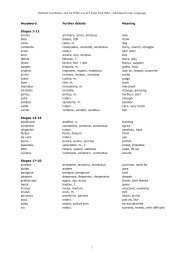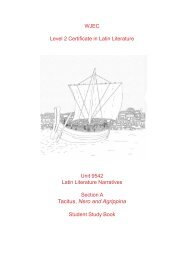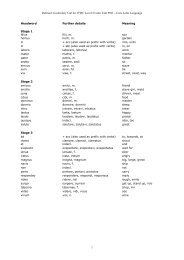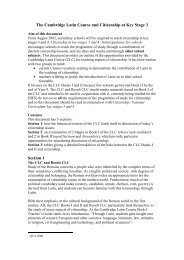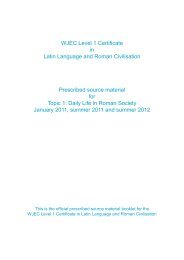2. Student Study Book - Cambridge School Classics Project
2. Student Study Book - Cambridge School Classics Project
2. Student Study Book - Cambridge School Classics Project
You also want an ePaper? Increase the reach of your titles
YUMPU automatically turns print PDFs into web optimized ePapers that Google loves.
1. Read lines 1-4 (aloud if possible) or listen to the audio on the CSCP website.<strong>2.</strong> <strong>Study</strong> the vocabulary.3. Read lines 1-4 (or listen to the audio) again.4. Who is this poem addressed to?5. What is the person (“I”, “you”, etc.) and tense of dicebas? Translate it.6. What noun or pronoun is described by solum in line 1? Catullum or te? (Hint: what is the gender of the personreferred to by te?)7. Look at two translations of the following sentence:puella vidit vinum servum consumere.The girl saw that the slave was drinking the wine.The girl saw that the wine was drinking the slave.From the point of view of grammar, both translations are satisfactory. But from the point of view of sense, onetranslation is fine and the other is rubbish.8. nosse is most conveniently translated as knew. The verb has many meanings; it can refer to knowing somebodyphysically, i.e. sexually, as in the 17th century English translation of the Bible: “And Adam knew Eve his wife;and she conceived, and bare Cain”.Further explanation of nosse, for experts only: it is a shortened form of novisse, the perfect infinitive of a verbnosco, which means I get to know, like cognosco in line 5. The present tense of nosco, and tenses formedfrom it, are not often found except in early Latin; much commoner are the perfect tense novi, novisti, etc., andtenses which are formed from it, used in the following way:perfect: novi = I have got to know = I knowpluperfect: noveram = I had got to know = I knew9. What was Lesbia once accustomed to say (line 1)? Two ways of taking the sentence are grammatically correct,but only one fits the situation, as in the example in question 7 above. Your answer to question question 6 mayalso be helpful here.10. What did Lesbia go on to say in line 2 about her wishes? (velle is the infinitive of volo, and Iovem is theaccusative case of Iuppiter.)11. The many meanings of tenere include hold in the arms, embrace, and so tenere can refer to physical lovemaking,like nosse in line 1 (and nubere in line 1 of Catullus, Poem 70).1<strong>2.</strong> Without looking back, can you recall the remark made about Jupiter by the mulier of Catullus and quoted byhim in Catullus, Poem 70? How similar is it to the remark by Lesbia quoted here in line 2? Is Catullus clearlyreferring to the same remark in both poems (in which case the mulier must be Lesbia)?13* Translate these two sentences:(a) vulgus amicam diligit.(b) pater gnatos et generos diligit.Both sentences talk about love. Do they talk about the same sort of love? If not, how do the two sorts differ?14. In what way (or ways) does Catullus describe the love he previously had for Lesbia (lines 3-4)?15* The comparison in line 4 does not occur anywhere else in Latin literature. One scholar has said of thecomparison: “It is brilliant and it does not quite come off.” Do you agree? Does it sound odd but still make clearthe difference between the two sorts of love? Your answer to the last part of question 13 may be helpful here.16. Translate lines 1-4.WJEC Level 2 Latin Literature Unit 9541 Love and Marriage 55



